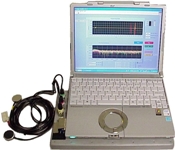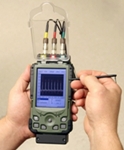Strategic Value for the Health & Safety Industry
The IT/MIS model has more to do with configuration management and much less with the job at hand, with little thought given to people in the field.
- By Richard Lane
- Jul 01, 2010
Long before there was a rugged mobile computer, I needed one. Fresh out of grad school, I stumbled upon a job opportunity in Santa Barbara as an environmental scientist. The only requirement for the position was familiarity with an organic vapor analyzer, or OVA. It was 1988, and the job involved using the OVA -- in this case, a Foxboro Flame Ionization Detector -- to measure fugitive emissions from process equipment in the production oil fields within California's South Coast Air Quality Management District. Regulatory compliance with SCAQMD Rule 1173 required that every valve, flange, tube fitting, dump lever arm, hatch, seal, man-way, door, and pressure relief valve be inspected for leaking hydrocarbons according to EPA Method 14.
Initially, we used clipboards and paper forms to log the OVA reading (% CH4) for the specific component (1/ 3x106) for that location/date and time with traceable calibration records. Furthermore, the inspection records had to be maintained in a database and reported on an annual basis indicating leaks, repairs, and quarterly re-inspections if leaks persisted. Needless to say, this is a monumental field data collection task, considering that an offshore oil platform in the Santa Barbara Channel has more than 3 million inspected components.
The petrochemical refineries have an even greater inventory of government-regulated process equipment. We soon found that every time we had to enter a tank or vessel in order to accomplish the EPA-driven inspections, we also were facing OSHA-driven compliance reporting for confined space entry (29 CFR 1910.146).
Operating as two- and three-man crews, we inspected many, if not all, of the on-shore and offshore oil production facilities from San Francisco to Huntington Beach. Ironically, we probably spent more money on metal clipboards, waterproof paper, copies, and redundant data entry than I spent last week on a new netbook.
Evolution of the Handheld
Within a year, I was looking for ways to improve our manual paper practices. I began working with the AIM gas detector company, an innovative group that had integrated gas detection sensors with datalogging instrumentation. Along the way, we went from sensors and paper to integrated datalogging, to notebook computers and handheld devices. The AIM 3000 had a SnO2 sensor for CH4 and two electrochemical sensors for O2 and H2S or CO, depending on the task at hand.
This handheld device could run for hours on lead acid batteries. It continuously monitored ambient air and logged the data in ASCII format for download via RS232 into a Lotus spreadsheet. Although at the time I did not know it, I was on the road to a career in rugged mobile computing. I spent the next decade traveling the world teaching hazmat teams, industrial hygienists, safety engineers, and other environmental scientists about the strategic value of this type of equipment to their respective industries.
About 10 years ago, the notebook form factor began to out sell the desktop computer, and IT departments were managing networks that were expanding well beyond walls and desks in dramatic ways. These notebooks were generating content and bringing data (and headaches) back into the organization in ways no one ever imagined. Connectivity via the Internet seemed to increase the growth in data expansion exponentially, and wireless networks began to amplify what was already becoming a science unto itself. Moore's Law demonstrated that bytes become KBs, which become MBs, and soon GBs will be terabytes.
- Faster/bigger/more: Faster processor, bigger applications, more memory. Yet it's the chant of the corporate technicians who actually have to buy and use this equipment that matters.
- Smaller/lighter/longer/cheaper: Smaller devices, lighter weight, longer-lasting batteries, and cheaper prices.
The strategic value of rugged mobile computing lies here, in the balance of these ironies.
Traditionally it is the IT/MIS department in an organization that drives the acquisition of mobile computers. The IT/MIS model has more to do with configuration management and much less with the job at hand. If specific application is addressed, it is usually in the context of integration with Enterprise IT. The result is the proliferation of commodity notebooks and a streamlining of configuration management for applications to create documents and share calendars. Little thought is given to people in the field and the job they must perform.
Although large global organizations such as FedEx and UPS have worked with manufacturers to build specialized rugged handheld devices, there remain tens of thousands of small to mid-sized companies that are faced with field computing dilemmas. These companies should consider rugged mobile computing as a solution.
Choosing a Rugged Computer
 Not all rugged computers are created equal. Look for true rugged design, where the computer is sealed to prevent dust and water ingress. The chassis should be both a heat sink and a rigid internal skeleton for protection from shock and vibration. Like a battleship, the design should contain "compartmentalization" creating fault tolerant isolation (FTI) for each of the main component groups, such as hard drives, batteries, device bays, and the mother board. This FTI not only protects each of the other areas from a failure, but also provides for very quick turnaround on RMA and repairs. Look for both Mean Time Between Failure (MTBF) and MTTR (Mean Time To Repair), as this is what determines how quickly an RMA can be returned to the field.
Not all rugged computers are created equal. Look for true rugged design, where the computer is sealed to prevent dust and water ingress. The chassis should be both a heat sink and a rigid internal skeleton for protection from shock and vibration. Like a battleship, the design should contain "compartmentalization" creating fault tolerant isolation (FTI) for each of the main component groups, such as hard drives, batteries, device bays, and the mother board. This FTI not only protects each of the other areas from a failure, but also provides for very quick turnaround on RMA and repairs. Look for both Mean Time Between Failure (MTBF) and MTTR (Mean Time To Repair), as this is what determines how quickly an RMA can be returned to the field.
Standards are important in rugged mobile computing, especially the military standard Mil Std 810F/G and 461, as well as Industrial Protection classification, IP xx. The first number is a rating for dust, and the second is for water. At a minimum, look for IP54. Where the occasional submersion may take place, consider the added security of IP65 or even IP67 (3' H2O/30 min.).
The real key in choosing a rugged mobile computer for use in the health & safety industry is factory customization. Customization involves integrating the sensors, peripheral devices, and software applications in a way that creates a more complete and durable solution. When a user adapts a commodity computer to his specific needs, he is faced with some sort of kit that is a hodgepodge of cables, chargers, and peripheral devices. Often, many of these components were never designed to work with his specific computer. Even when done by experienced IT technicians, this out-of-factory customization often produces less-than-elegant results.
Factory customization transforms this spaghetti complex of components into a truly rugged computer, one that functions better and lasts longer. End users find it easier to utilize, and there is less likelihood of equipment failure or loss. Above all, the purchasing agent should ensure the computer's manufacture, lifecycle management, and the customization are handled under one warranty. No one wants to spend time chasing down third-party vendors.
It may be counter-intuitive, but a little more money spent on factory customization will provide a much greater return on investment (ROI) than an off-the-shelf commodity computer.
 Here are a few examples where factory customization creates much better value. Technology to detect minor traumatic brain injury on the battlefield was contained in a box under a notebook, but after custom integration, the electronics were reduced to a small module that fits inside and on the back of a rugged PDA -- much better for the battlefield medic! In a second example, an external module to collect biometric imagery (face, finger, iris, voice, and latent fingerprint) is connected to a tablet computer, and although this is a dramatic reduction in size from previous multi-camera "jump kit" solutions, it is inferior to the fully rugged handheld solution. In the third example, technology to detect coronary artery disease is housed in an external serial device, but after custom integration, the data acquisition module is internal to the computer, which allowed the entire system to be IEC60601 certified as one product. Our final example: Technology to measure and analyze ambient noise is strung out in several devices with cables in between
Here are a few examples where factory customization creates much better value. Technology to detect minor traumatic brain injury on the battlefield was contained in a box under a notebook, but after custom integration, the electronics were reduced to a small module that fits inside and on the back of a rugged PDA -- much better for the battlefield medic! In a second example, an external module to collect biometric imagery (face, finger, iris, voice, and latent fingerprint) is connected to a tablet computer, and although this is a dramatic reduction in size from previous multi-camera "jump kit" solutions, it is inferior to the fully rugged handheld solution. In the third example, technology to detect coronary artery disease is housed in an external serial device, but after custom integration, the data acquisition module is internal to the computer, which allowed the entire system to be IEC60601 certified as one product. Our final example: Technology to measure and analyze ambient noise is strung out in several devices with cables in between
In sum, custom integration resulted in a very elegant rugged mobile solution with high value to the occupational safety and health industry.
This article originally appeared in the July 2010 issue of Occupational Health & Safety.